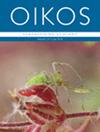Estimated missing interactions change the structure and alter species roles in one of the world's largest seed‐dispersal networks
IF 3
2区 环境科学与生态学
Q2 ECOLOGY
引用次数: 0
Abstract
Ecological interactions between species can affect the performance of individuals, influence ecological and evolutionary dynamics of populations, and ultimately shape community structure. Therefore, documenting and studying interactions is necessary for a better comprehension of ecological patterns. Yet, sampling interactions in the field is challenging. Even with extensive sampling efforts we can hardly obtain a comprehensive picture of which species interact with each other. Such missing interactions can produce substantial gaps that affect how we perceive and interpret the network formed by species interactions and the roles of individual species within those networks. In this study we propose two methods that combine data on species interactions with information on species traits and phylogenies to estimate potentially missing interactions. We use one of the largest datasets on plant‐frugivore interactions, depicting thousands of interactions between birds and plants in the Atlantic Forest hotspot, to test those methods. Then, we analyze how adding newly estimated interactions change the network's overall structure and the topological importance of each species within the seed‐dispersal network. We show that estimated missing interactions more than tripled the number of interactions in the network and impact the general topological properties of the network increasing nestedness and reducing modularity. Both methods generated networks with a similar structure and were effective in estimating new interactions, accurately predicting known interactions without overestimating interactions in place of true absences. More importantly, added interactions changed our perception on the topological role of species, with several undersampled species earning novel interactions and becoming more central to network structure. This shows that estimating missing interactions can be helpful to get a more complete idea of how a network may look like, besides helping to inform which interactions should be the focus of further sampling efforts.估计缺失的相互作用改变了世界上最大的种子传播网络之一的结构,并改变了物种的作用
物种之间的生态相互作用会影响个体的表现,影响种群的生态和进化动态,并最终形成群落结构。因此,为了更好地理解生态模式,有必要记录和研究相互作用。然而,在野外对相互作用进行取样具有挑战性。即使进行了大量取样工作,我们也很难全面了解哪些物种之间存在相互作用。这种缺失的相互作用会产生巨大的空白,影响我们对物种相互作用所形成的网络以及单个物种在这些网络中的作用的认识和解释。在这项研究中,我们提出了两种方法,将物种相互作用数据与物种特征和系统发育信息结合起来,估算可能缺失的相互作用。我们使用最大的植物-食草动物相互作用数据集之一来测试这些方法,该数据集描述了大西洋森林热点地区数千种鸟类与植物之间的相互作用。然后,我们分析了添加新估算的相互作用会如何改变网络的整体结构以及种子传播网络中每个物种的拓扑重要性。我们发现,估计的缺失交互作用使网络中的交互作用数量增加了两倍多,并影响了网络的总体拓扑特性,增加了嵌套性,降低了模块性。这两种方法生成的网络结构相似,都能有效估计新的相互作用,准确预测已知的相互作用,而不会高估取代真实缺失的相互作用。更重要的是,新增的相互作用改变了我们对物种拓扑作用的看法,一些取样不足的物种获得了新的相互作用,并成为网络结构的核心。这表明,估计缺失的相互作用有助于更全面地了解一个网络可能是怎样的,此外还有助于了解哪些相互作用应该成为进一步取样工作的重点。
本文章由计算机程序翻译,如有差异,请以英文原文为准。
求助全文
约1分钟内获得全文
求助全文
来源期刊

Oikos
环境科学-生态学
CiteScore
6.20
自引率
5.90%
发文量
152
审稿时长
6-12 weeks
期刊介绍:
Oikos publishes original and innovative research on all aspects of ecology, defined as organism-environment interactions at various spatiotemporal scales, so including macroecology and evolutionary ecology. Emphasis is on theoretical and empirical work aimed at generalization and synthesis across taxa, systems and ecological disciplines. Papers can contribute to new developments in ecology by reporting novel theory or critical empirical results, and "synthesis" can include developing new theory, tests of general hypotheses, or bringing together established or emerging areas of ecology. Confirming or extending the established literature, by for example showing results that are novel for a new taxon, or purely applied research, is given low priority.
 求助内容:
求助内容: 应助结果提醒方式:
应助结果提醒方式:


